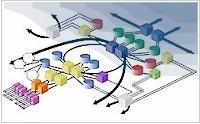|
|
Advanced Digital Design CS-43305 / CS 53305 Fall 2020
|
|
|
|
 Course Description
Course Description
The course describes techniques in the design of digital systems. Topics covered include combinational and sequential logic, gate-level minimization, registers and counters, memory and programmable logic, hardware description languages, digital communication including serial and parallel and synchronous and asynchronous methods. This is a 3 credit-hour course.
Prerequisites: Minimum C or better in CS 23001
|
 Course Learning Outcomes
Course Learning Outcomes
Recall how binary numbers are integral to digital design
Find the optimal gate-level implementation of Boolean functions describing a digital circuit
Recall various concepts related to combinational logic circuits including: decoder, encoder, multiplexer and three-state gate
Analyze Combinational circuits
Analyze synchronous sequential logic
Write Hardware Description Language (Verilog) programs for a gate-level (structural) models and test bench
Write Verilog programs for behavioral models and testbenches
Differentiate between a sequential circuit and a combinational circuit
Develop simulations of digital systems
 Syllabus and Course Schedule
Syllabus and Course Schedule
You will find the course syllabus and schedule with information about the purpose, structure, policies, and requirements for the course
 Learning Materials
Learning Materials
Module 1: Digital Systems and Binary Numbers
This module will discuss various binary systems suitable for representing information in digital systems. The binary number system is explained, and binary codes are illustrated. Examples are given for addition and subtraction of signed binary numbers and decimal numbers in binary-coded decimal (BCD) format.
Module 2: Boolean Algebra and Logic Gates
Foundation in Boolean algebra that enables students to optimize simple circuits, and to understand the purpose of algorithms used to optimize complex circuits involving millions of logic circuits.
Module 3: Gate-Level Minimization
This module focuses on the design tasks of finding an optimal gate-level implementation of the Boolean functions that describes a digital circuit. It enables students to execute a manual design of simple circuits, and prepares students for skilled use of modern design tools
Module 4: Combinational Logic
This module examines the characteristics and implementations of combinational circuits. A logic circuit is combinational if its output at any time are a function of only the present inputs
Module 5: Synchronous Sequential Logic
Hand-held devices, cell phones, navigation systems, digital cameras, media players, and virtually all electronic consumer products have the ability to send, receive, store, retrieve and process information stored in a binary format. This module examines the operation and control of these devices and their use in circuits
Module 6: Registers and Counters
Circuits that include flip-flops are usually classified by the function they perform rather than by the name of the sequential circuit. Two such circuits are registers and counters
Module 7: Advanced Verilog with Applications
This module examines advanced Verilog constructs and their applications
Module 8: Simulations of Digital Systems using Hardware Description Langulage
This module uses the Verilog tool to solve a set of problems common to digital devices
|
 Lab Projects
Lab Projects
|
|
|








